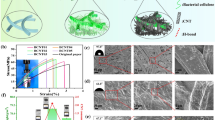Abstract
As a novel piezoelectric material, the mechanical and piezoelectric properties of cellulose electro-active paper (EAPap) were studied. Young’s modulus of piezoelectric EAPap was dependant on the material orientation as compared with other EAP materials. The highest Young’s modulus was obtained at 0° direction, while the highest direct piezoelectric charge constant was achieved at 45°. By measuring the induced output voltage from the thin piezoelectric cellulose film under the applied impact force, we demonstrate that piezoelectric EAPap film has a potential for sensor applications.
Similar content being viewed by others
References
Shahinpoor M, Bar-Cohen Y, Simpson Y O, et al. Ionic polymer-metal composites (IPMCs) as biomimetic sensors, actuators and artificial muscles-a review. Smart Mater Struc, 1998, 7: R15–R30
Calvert P, Liu Z. Free form fabrication of hydrogels. Acta Mate, 1998, 46:2565–2571
MacDiarmid A G, Chiang J C, Halpern M, et al. Polyaniline: interconversion of metallic and insulating forms. Mole Crys Liquid Cry, 1985, 121: 173–180
Dresselhaus M S, Dresselhaus G, Avouris P. Carbon Nanotubes: Synthesis, Structure, Properties and Applications, Topics in Applied Physics Berlin: Springer 2001. 80
Pelrine R, Kornbluh R, Joseph J. Electrostriction of polymer dielectrics with compliant electrodes as a means of actuation. Sensor and Actuators A: Physical, 1998, 64: 77–85
Su J, Harrison J S, St. Clair T L, et al. Electrostrictive Graft Elastomers and Applications. In: Proceeding of Materials Research Society Symposia, 2000, 600: 131–136
Zhang Q M, Bharti V, Zhao X. Giant electrostriction and relaxor ferroelectric behavior in electron-Irradiated poly(vinylidene fluoride -trifluoroethylene) copolymer. Science, 1998, 280: 2101–2104
Koyama K, Minagawa K, Watanabe T, et al. Electro-magneto-Rheological effects in parallel-field and crossed field systems. J non-Newtonian Fluid Mech, 1995, 58: 195–206
Yun S, Kim J, Song C S. Performance of electro-active paper actuators with thickness variation. Sensors and Actuators A, 2007, 133: 225–230
Yun S, Kim J. Discovery of cellulose as a smart material. Macromolecules, 2006, 39: 4202–4206
Hillenbrand J, Sessler G M. Piezoelectricity in cellular electret films. IEEE Transactions on Dielectrics and Electrical Insulation, 2000, 7: 556–560
Bowen C R, Perry A, Lewis A C F, et al. Processing and properties of porous piezoelectric materials with high hydrostatic figures of merit. J Euro Ceramic Soc, 2004, 24: 541–545
Fukada E. Piezoelectricity as fundamental property of wood. Wood Sci and Technol, 1968, 2: 299–307
Yun S, Kim J, Kim HS, et al. Fabrication and characterization of Piezo-paper made with cellulose. In: Proceeding of SPIE, 2008, in press
Sugiyama J, Chanzy H, Maret G. Orientation of cellulose microcrystals by strong magnetic fields. Macromolecules, 1992, 25: 4232–4234
Kimura F, Kimura T, Tamura M, et al. Magnetic alignment of the chiral nematic phase of a cellulose microfibril suspension. Langmuir, 2005, 21: 2034–2037
Bordel D, Putaux J L, Heux L. Orientation of native cellulose in an electric field. Langmuir, 2006, 22: 4899–4901
Kondo T, Togawa E, Malcolm Brown R Jr. Nematic ordered cellulose: a concept of glucan chain association. Biomacromolecules, 2001, 2: 1324–1330
Kim J, Seo B Y. Electro-active paper actuators. Smart Mater Struc, 2002, 11:355–360
Kim J, Song C S, Yun S. Cellulose based electro-active papers: performance and environmental effects. Smart Mater Struct, 2006, 15: 719–723
Park I S, Kim S M, Kim D, et al. The mechanical properties of ionic polymer-metal composites. In: Proceeding of SPIE, 2007, 6524: 6524R1–R11
Chen Q, Natala D, Beese B, et al. Piezoelectric polymers actuators for precise shape control of large scale space antennas, In: Proceeding of SPIE, 2007, 6524: 65241P1–P11
Lopez M, Sanchez H. Characterization of piezoelectric materials as a power source for electronic implantation devices. Microelectronics J, 2008, 39: 1306–1307
Author information
Authors and Affiliations
Corresponding authors
Additional information
Supported by the Korea Research Foundation Grant (KRF-2008-314-D00009) and Creative Research Initiative (EAPap Actuator) of KOSEF/MEST in South Korea
About this article
Cite this article
Lee, SW., Kim, JH., Kim, J. et al. Characterization and sensor application of cellulose electro-active paper (EAPap). Chin. Sci. Bull. 54, 2703–2707 (2009). https://doi.org/10.1007/s11434-009-0219-y
Received:
Accepted:
Published:
Issue Date:
DOI: https://doi.org/10.1007/s11434-009-0219-y




